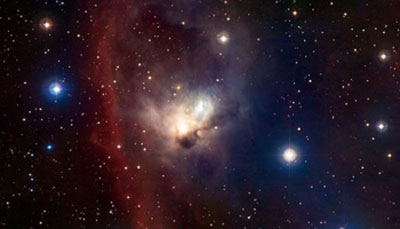Water discovered in remnants of rocky exoplanet
Update: 13-10-2013 | 00:00:00
British astronomers said Thursday they have found the first evidence of a water-rich rocky planetary body outside our solar system in its shattered remains. Using observations obtained with the Hubble Space Telescope and the large Keck telescope on Hawaii, researchers from the Universities of Warwick and Cambridge analyzed the dust and debris surrounding a white dwarf called GD61, a small but incredibly dense burned-out star that lies 170 light years away.The researchers reported in the U.S. journal Science that they found an excess of oxygen, a chemical signature that indicates the debris had once been part of a bigger body originally composed of 26 percent water by mass. By contrast, only approximately 0.023 percent of the Earth's mass is water.Evidence for water outside our solar system has previously been found in the atmosphere of gas giants, but this study marks the first time it has been pinpointed in a rocky body."Those two ingredients -- a rocky surface and water -- are key in the hunt for habitable planets outside our solar system so it's very exciting to find them together for the first time outside our solar system," co-author Boris Gansicke from the University of Warwick, said in a statement.The researchers suggest it is most likely that the water detected around the white dwarf GD61 came from a minor planet at least 90 km in diameter but potentially much bigger, that once orbited the parent star before it became a white dwarf.About 200 million years ago, GD61 entered its death throes and became a white dwarf, yet, parts of its planetary system survived. The water-rich minor planet was pulled out of its regular orbit and plunged into a very close orbit, where it was shredded by the star's gravitational force.To date observations of 12 destroyed exoplanets orbiting white dwarves have been carried out, but this is the first time the signature of water has been found, the researchers said."The finding of water in a large asteroid means the building blocks of habitable planets existed -- and maybe still exist -- in the GD61 system, and likely also around substantial number of similar parent stars," said lead author Jay Farihi from the University of Cambridge."These water-rich building blocks, and the terrestrial planets they build, may in fact be common -- a system cannot create things as big as asteroids and avoid building planets, and GD61 had the ingredients to deliver lots of water to their surfaces," Farihi said. "Our results demonstrate that there was definitely potential for habitable planets in this exoplanetary system."Six billion years from now, our Sun will collapse and, possibly, evolve into a white dwarf. Therefore, "it's a look into our future," said Gansicke.Xinhuanet
Using observations obtained with the Hubble Space Telescope and the large Keck telescope on Hawaii, researchers from the Universities of Warwick and Cambridge analyzed the dust and debris surrounding a white dwarf called GD61, a small but incredibly dense burned-out star that lies 170 light years away.The researchers reported in the U.S. journal Science that they found an excess of oxygen, a chemical signature that indicates the debris had once been part of a bigger body originally composed of 26 percent water by mass. By contrast, only approximately 0.023 percent of the Earth's mass is water.Evidence for water outside our solar system has previously been found in the atmosphere of gas giants, but this study marks the first time it has been pinpointed in a rocky body."Those two ingredients -- a rocky surface and water -- are key in the hunt for habitable planets outside our solar system so it's very exciting to find them together for the first time outside our solar system," co-author Boris Gansicke from the University of Warwick, said in a statement.The researchers suggest it is most likely that the water detected around the white dwarf GD61 came from a minor planet at least 90 km in diameter but potentially much bigger, that once orbited the parent star before it became a white dwarf.About 200 million years ago, GD61 entered its death throes and became a white dwarf, yet, parts of its planetary system survived. The water-rich minor planet was pulled out of its regular orbit and plunged into a very close orbit, where it was shredded by the star's gravitational force.To date observations of 12 destroyed exoplanets orbiting white dwarves have been carried out, but this is the first time the signature of water has been found, the researchers said."The finding of water in a large asteroid means the building blocks of habitable planets existed -- and maybe still exist -- in the GD61 system, and likely also around substantial number of similar parent stars," said lead author Jay Farihi from the University of Cambridge."These water-rich building blocks, and the terrestrial planets they build, may in fact be common -- a system cannot create things as big as asteroids and avoid building planets, and GD61 had the ingredients to deliver lots of water to their surfaces," Farihi said. "Our results demonstrate that there was definitely potential for habitable planets in this exoplanetary system."Six billion years from now, our Sun will collapse and, possibly, evolve into a white dwarf. Therefore, "it's a look into our future," said Gansicke.Xinhuanet
 Using observations obtained with the Hubble Space Telescope and the large Keck telescope on Hawaii, researchers from the Universities of Warwick and Cambridge analyzed the dust and debris surrounding a white dwarf called GD61, a small but incredibly dense burned-out star that lies 170 light years away.The researchers reported in the U.S. journal Science that they found an excess of oxygen, a chemical signature that indicates the debris had once been part of a bigger body originally composed of 26 percent water by mass. By contrast, only approximately 0.023 percent of the Earth's mass is water.Evidence for water outside our solar system has previously been found in the atmosphere of gas giants, but this study marks the first time it has been pinpointed in a rocky body."Those two ingredients -- a rocky surface and water -- are key in the hunt for habitable planets outside our solar system so it's very exciting to find them together for the first time outside our solar system," co-author Boris Gansicke from the University of Warwick, said in a statement.The researchers suggest it is most likely that the water detected around the white dwarf GD61 came from a minor planet at least 90 km in diameter but potentially much bigger, that once orbited the parent star before it became a white dwarf.About 200 million years ago, GD61 entered its death throes and became a white dwarf, yet, parts of its planetary system survived. The water-rich minor planet was pulled out of its regular orbit and plunged into a very close orbit, where it was shredded by the star's gravitational force.To date observations of 12 destroyed exoplanets orbiting white dwarves have been carried out, but this is the first time the signature of water has been found, the researchers said."The finding of water in a large asteroid means the building blocks of habitable planets existed -- and maybe still exist -- in the GD61 system, and likely also around substantial number of similar parent stars," said lead author Jay Farihi from the University of Cambridge."These water-rich building blocks, and the terrestrial planets they build, may in fact be common -- a system cannot create things as big as asteroids and avoid building planets, and GD61 had the ingredients to deliver lots of water to their surfaces," Farihi said. "Our results demonstrate that there was definitely potential for habitable planets in this exoplanetary system."Six billion years from now, our Sun will collapse and, possibly, evolve into a white dwarf. Therefore, "it's a look into our future," said Gansicke.Xinhuanet
Using observations obtained with the Hubble Space Telescope and the large Keck telescope on Hawaii, researchers from the Universities of Warwick and Cambridge analyzed the dust and debris surrounding a white dwarf called GD61, a small but incredibly dense burned-out star that lies 170 light years away.The researchers reported in the U.S. journal Science that they found an excess of oxygen, a chemical signature that indicates the debris had once been part of a bigger body originally composed of 26 percent water by mass. By contrast, only approximately 0.023 percent of the Earth's mass is water.Evidence for water outside our solar system has previously been found in the atmosphere of gas giants, but this study marks the first time it has been pinpointed in a rocky body."Those two ingredients -- a rocky surface and water -- are key in the hunt for habitable planets outside our solar system so it's very exciting to find them together for the first time outside our solar system," co-author Boris Gansicke from the University of Warwick, said in a statement.The researchers suggest it is most likely that the water detected around the white dwarf GD61 came from a minor planet at least 90 km in diameter but potentially much bigger, that once orbited the parent star before it became a white dwarf.About 200 million years ago, GD61 entered its death throes and became a white dwarf, yet, parts of its planetary system survived. The water-rich minor planet was pulled out of its regular orbit and plunged into a very close orbit, where it was shredded by the star's gravitational force.To date observations of 12 destroyed exoplanets orbiting white dwarves have been carried out, but this is the first time the signature of water has been found, the researchers said."The finding of water in a large asteroid means the building blocks of habitable planets existed -- and maybe still exist -- in the GD61 system, and likely also around substantial number of similar parent stars," said lead author Jay Farihi from the University of Cambridge."These water-rich building blocks, and the terrestrial planets they build, may in fact be common -- a system cannot create things as big as asteroids and avoid building planets, and GD61 had the ingredients to deliver lots of water to their surfaces," Farihi said. "Our results demonstrate that there was definitely potential for habitable planets in this exoplanetary system."Six billion years from now, our Sun will collapse and, possibly, evolve into a white dwarf. Therefore, "it's a look into our future," said Gansicke.Xinhuanet
 Malaysia, Singapore step up cooperation in environmental protection
Malaysia, Singapore step up cooperation in environmental protection
 Malaysia's digital economy projected to reach 31 billion USD in 2024
Malaysia's digital economy projected to reach 31 billion USD in 2024
 Opportunity to enhance the position of the Global South
Opportunity to enhance the position of the Global South
 Thailand to build new bridge to Cambodia
Thailand to build new bridge to Cambodia
 Bulgaria charts new course with Vietnam on President’s upcoming visit: Diplomat
Bulgaria charts new course with Vietnam on President’s upcoming visit: Diplomat
 Seminar seeks ways to boost ASEAN - Latin America connectivity
Seminar seeks ways to boost ASEAN - Latin America connectivity
 Indonesia seeks India's help in health education
Indonesia seeks India's help in health education
 Indonesia named world's most generous country in 2024
Indonesia named world's most generous country in 2024
 Philippines: Over-4m-high floodwaters make thousands of houses submerged
Philippines: Over-4m-high floodwaters make thousands of houses submerged
 Singapore’s public sector records carbon reduction in 2023
Singapore’s public sector records carbon reduction in 2023



